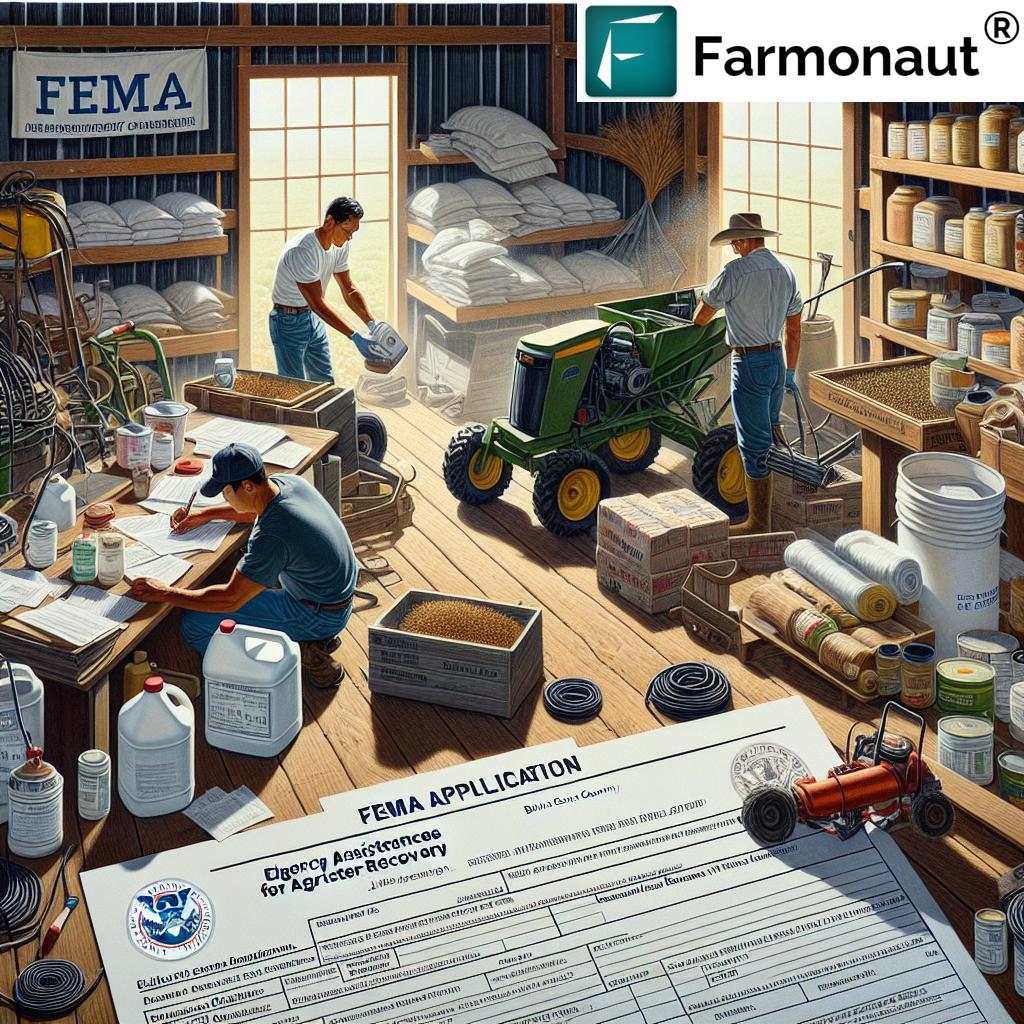7 FEMA Tools for Disaster Assistance in Butler County Farming
Table of Contents
- Introduction: Disaster Assistance for Farmers in Butler County
- Why Disaster Assistance for Farmers Is Essential
- Eligible Tools, Equipment, and Supplies: A Complete Guide
- FEMA Disaster Assistance Tools Comparison Table
- The 7 FEMA Tools for Disaster Assistance
- Eligibility Criteria: Who Can Apply?
- How to Apply for Disaster Assistance
- Additional Federal Support & Farmonaut Tools
- Post-Storm Recovery Timeline: What to Expect
- Farmonaut Solutions: Empowering Farmers After Storms
- Frequently Asked Questions
- Farmonaut Subscription Plans
Introduction: Disaster Assistance for Farmers in Butler County
When severe storms swept through Butler County, Kentucky in February and April, many of us in the farming community faced significant losses. Not only were fields impacted, but the essential tools, equipment, and supplies we rely on for daily farming operations suffered damage. In these challenging times, disaster assistance for farmers becomes our vital lifeline.
Working the land in Butler County means understanding that weather can change everything overnight. This is why the Federal Emergency Management Agency (FEMA) has made emergency assistance for agricultural workers available, offering help to replace disaster-damaged tools and equipment critical for our employment and self-employment.
In this comprehensive guide, we will explore the seven key FEMA tools and assistance programs available to us as farmers and ranch hands, provide a detailed look at eligible equipment for disaster recovery, and explain, step-by-step, how to apply for disaster assistance. We’ll also discuss how Farmonaut’s precision agriculture solutions complement FEMA assistance for ongoing farm recovery.
Why Disaster Assistance for Farmers Is Essential
Severe storms don’t just disrupt our crops and livestock; they also hit our ability to farm effectively. Whether it’s tractors stuck in the mud, plows and planters ruined by hail, or utility vehicles rendered useless by flooding, losing the essential equipment we need for daily operations can grind a farming business to a halt. For ranch hands, whose employment depends upon access to tools supplied by employers, the stakes are equally high.
FEMA’s assistance for farming operation recovery is designed to help us replace damaged farm equipment and return to work as quickly as possible. Having a clear understanding of which tools and equipment are eligible for assistance after a disaster, as well as the steps needed to apply for FEMA assistance, is crucial for both immediate recovery and ongoing farm success.
Eligible Tools, Equipment, and Supplies: A Complete Guide
When disasters strike, it’s critical for us to know which tools and equipment may be replaced through federal help for disaster-damaged tools in Butler County. FEMA outlines which items are likely to be eligible for disaster assistance for farmers depending on their role in daily operations.
What Tools and Equipment Are Eligible?
- Tractors: If your tractor was damaged or destroyed by storms, you may be eligible to receive assistance to replace it, especially if it is essential for your employment or self-employment in farming.
- Plows, Seeders, and Planters: These vital tools for prepping and planting can be covered if damaged by disasters.
- Harvesters: Combines and other harvest equipment that are not covered by insurance can often be replaced with disaster assistance support.
- Sprayers, Hay Balers, and Utility Vehicles: Machinery used for ongoing operations in the field or for livestock management may qualify for assistance.
- Specialty Tools for Ranch Hands: Tools or equipment required by your employer may also be eligible if you can show their necessity for your employment.
- Other Essential Supplies: This may include items critical to your farming trade or profession, not generally supplied by your employer and necessary for you to earn a living.
Note: Crops and livestock are products of farming operations—not tools and equipment—so they are NOT eligible under this category of FEMA assistance.
FEMA Disaster Assistance Tools Comparison Table
| Tool Name | Eligible Equipment/Supplies (Est. Value/Range) | Primary Purpose | Eligibility Criteria | Application Steps (Est. Time) | Post-Storm Availability (Estimated Timeline) |
|---|---|---|---|---|---|
| Tractor Replacement Assistance | Tractors ($10,000–$300,000) | Restore core machinery for land and crop management | Prove disaster damage and use for employment/self-employment | Register with FEMA, document damage, submit receipts; 2–4 weeks | 2–6 weeks after claim approval |
| Plow, Seeder & Planter Tools Assistance | Plows, seeders, planters ($1,500–$50,000) | Re-establish planting operations | Not covered by insurance, essential for work | Register, provide employer note (if needed); 2–3 weeks | 1–4 weeks |
| Harvester Replacement Grants | Harvesters, combines ($15,000–$400,000) | Recover harvesting capability | Must have proof of use in farming operation; uninsured | Register, damage assessment, supply documentation; 2–5 weeks | 2–5 weeks |
| Sprayers & Utility Vehicles Assistance | Sprayers, balers, ATVs, utility vehicles ($2,000–$75,000) | Rebuild application and transport effectiveness | Show item required for trade/profession | Register, submit work history or education proof; 2–3 weeks | 1–3 weeks |
| Essential Supply Replacement | Safety gear, small tools, ranch supplies ($300–$18,000) | Restore daily working conditions | Replacement needed for employment or education | FEMA form, supply lists, employer note; 1–2 weeks | 1–2 weeks |
| Ranch Hands’ Employment Tools Assistance | Hand tools, fencing, tack ($250–$12,000) | Replace items required by employer for job | Employer requirement, item not employer-supplied | Register, employer documentation; 1–2 weeks | 1–2 weeks |
| Specialized Trade/Professional Equipment Replacement | Veterinary/special trade tools ($400–$18,000) | Maintain professional/educational activities | For use in specific farming trade or study | Register, provide proof of education/trade; 1–2 weeks | 1–3 weeks |
The 7 FEMA Tools for Disaster Assistance
Let’s break down each FEMA program or “tool” available to us as Butler County farmers and ranch hands for disaster aid. Our goal: help you understand the tools and equipment eligibility criteria and walk you through exactly how disaster assistance for farmers works in practice.
1. Tractor Replacement Assistance
- Our tractors are irreplaceable assets. If a storm or flood has made your main tractor unusable, FEMA’s program can help replace damaged farm equipment so we can return to fieldwork faster.
- Eligibility: Must show that tractor is required for our employment or self-employment in a farming operation and that damage was caused by a declared disaster.
- How to Apply: Register for FEMA, provide proof of ownership and documentation of the damage. If you filed for insurance, show what is not covered.
2. Plow, Seeder & Planter Tools Assistance
- Spring planting depends on effective soil preparation and seeding. FEMA offers disaster assistance for farmers who need to replace plows, seeders, and planters lost in Butler County storms.
- Eligibility: Proof of employment or ownership, insurance claim details, and evidence that the tool is vital to your farming operation.
- Example: For custom operators or contract farmers, having these implements may be a condition of employment or a professional necessity.
3. Harvester Replacement Grants
- With harvest season looming, a lost combine or harvester can devastate our profits and livelihood. FEMA supports rapid replacement of disaster-damaged harvesters.
- Eligibility: Must show the harvester is not insured, is required for your trade, and was damaged in the eligible disaster.
- Note: Sprayers and balers may also qualify under similar criteria, especially if not provided by a third-party employer.
4. Sprayers & Utility Vehicles Assistance
- For crop management, application equipment and utility vehicles are essential. FEMA programs enable us to replace damaged sprayers, hay balers, and utility vehicles if a documented need is established.
- Eligibility Criteria: Must show the role of the equipment in your farming operation or employment, and document what insurance does not cover.
5. Essential Supply Replacement
- Loss of day-to-day working supplies—from fencing and tack for ranch hands to seed stock for planters—can interrupt our schedules for months. FEMA’s assistance covers such essential supplies for ranch hands and specialty farmers.
- Examples: Safety gear, high-visibility clothing, basic hand tools, or other items critical to continued employment or self-employment in farming.
6. Ranch Hands’ Employment Tools Assistance
- If we are ranch hands or farm laborers who must bring our own tools, FEMA assistance can cover items destroyed in a disaster—provided proof these are not supplied by our employer and are required for trade or employment.
- Eligibility: Typically, a written statement from your employer is necessary to show item necessity and non-provision.
7. Specialized Trade/Professional Equipment Replacement
- Some of us need unique tools for education, veterinary work, or niche agricultural trades. As long as we demonstrate that the equipment is required for our professional/educational activities and not employer-supplied, FEMA may help replace disaster-damaged items.
- Examples: Soil sensors, GPS units for precision planting, or veterinary kits for livestock care.
Eligibility Criteria: Who Can Apply?
Before you apply for disaster assistance, ensure you meet FEMA’s criteria for eligible equipment for disaster recovery in Butler County:
- You must be a resident or operate a farm or ranch in the federally declared disaster area (Butler County, KY as per recent FEMA releases).
- You must have lost or had essential equipment, tools, or supplies damaged by a covered disaster (February and April storms included).
- Crops and livestock do not count as eligible equipment—they’re considered products, not tools, by FEMA.
- If you are a ranch hand, you must show the item is not supplied by your employer but is a condition of employment.
- Items must not be covered, or must only be partially covered, by insurance.
- Self-employed farmers must show how each item is required for their trade or profession.
- Students or apprentices in an agricultural education or trade program may qualify if the tools are required for coursework and not provided by the school.
Still not sure? Consult the Butler County Extension Office or the local FEMA Disaster Recovery Center for guidance about the eligibility specifics for your situation.
How to Apply for Disaster Assistance (Step-by-Step Guide)
Applying for FEMA disaster assistance for farmers can feel complicated, but we’ve drafted a step-by-step process to simplify your journey to receiving crucial federal help after severe storms.
- Document Damage Immediately: As soon as it’s safe, take photos or videos of all damaged tools, equipment, and supplies. Keep written notes of when, where, and how the damage occurred.
- Check Your Insurance Policy: File an insurance claim first. FEMA only steps in to replace what insurance does not fully cover.
- Register with FEMA: Call 1-800-621-FEMA (3362), go to disasterassistance.gov, or visit a Disaster Recovery Center in Butler County.
- Prepare Documentation: Gather proof of residence, ownership, or employment, insurance denial/partial payment letters, and employer documentation if you are a ranch hand.
- Fill Out Application Forms: Complete FEMA’s application thoroughly, listing every piece of damaged or destroyed equipment and the supplies required for your trade, profession, or education.
- Submit and Monitor Your Application: Track your application status through the FEMA website, by phone, or at the local disaster center.
- Schedule a FEMA Inspector Visit (If Requested): A FEMA agent may come to your property to assess the damages firsthand.
- Receive and Review Assistance Offer: Once processed, FEMA will send you documentation about available disaster assistance for eligible tools and equipment. Review carefully before accepting.
- Appeal if Needed: If your claim is denied or the offer doesn’t seem to reflect your losses, file an appeal with additional documentation.
For most eligible equipment for disaster recovery, applications can be started within days of a declaration, and most decisions are rendered in 2–6 weeks.
Additional Federal Support & Farmonaut Tools
Alongside FEMA, the Small Business Administration (SBA) and the U.S. Department of Agriculture (USDA) provide financial assistance and low-interest loans for farm and ranch disaster recovery. This holistic approach aims to replace damaged farm equipment and cover recovery gaps not filled by FEMA alone.
- The SBA can help finance larger-equipment purchases when FEMA’s grant cap is not sufficient.
- The USDA offers emergency loans and guidance for replacing tools, restocking supplies, and restoring operations.
To maximize recovery, it is wise to combine federal help for disaster-damaged tools with advanced technology solutions. For instance, the Farmonaut Carbon Footprinting Tool empowers us to monitor and reduce our farm’s environmental impact during rebuilding. Similarly, Farmonaut’s Blockchain-Based Traceability system can help validate the origin of products in disaster-affected supply chains, enhancing transparency and trust—critical during post-storm recovery when channel trust is paramount.
If you operate a large-scale farm or manage a fleet of productive vehicles, the Farmonaut Fleet Management Solution enables you to monitor all vehicle activity in real-time—ensuring efficient use of any machinery you replace through FEMA or other disaster support channels.
Post-Storm Recovery Timeline: What to Expect
Every day without essential farming equipment impacts our yields and business. Here’s an estimated FEMA disaster recovery timeline based on Butler County’s response to previous incidents:
- First 2–3 days post-storm: Document all damages and begin insurance claims.
- By week 1: Register with FEMA and prepare all supporting documentation.
- Within 2–3 weeks: Expect a response from FEMA regarding your application status. If awarded, initial funds may be disbursed for essential supply replacement and smaller tools.
- By weeks 4–6: Larger equipment replacement is processed; inspections may be completed for tractors, harvesters, or utility vehicles.
- By 2 months: Most eligible recovery items will be supplied or replaced, barring any documentation issues or appeals.
Remember: Patience, careful documentation, and proactive communication with FEMA and USDA representatives help ensure smooth, timely access to disaster assistance.
Farmonaut Solutions: Empowering Farmers After Storms
As we recover from natural disasters, leveraging technology accelerates our journey back to sustainable and profitable farming. Farmonaut offers a suite of digital technologies complementary to federal recovery programs:
- Satellite-based Crop Health Monitoring: With real-time multispectral imagery on Farmonaut’s app and web platform, we track post-storm crop recovery, optimize input usage, and spot issues early.
-
AI-Powered Farm Advisory: The Jeevn AI system provides us with personalized advice, updated weather forecasts, and actionable alerts to improve operational decisions after severe weather events.
Try Jeevn AI via the Farmonaut app - Blockchain-based Product Traceability: Re-establish market trust for our outputs post-disaster by validating every step of the supply chain with Farmonaut Traceability solutions.
- Fleet & Resource Management: Efficiently allocate newly replaced tools and vehicles using Farmonaut’s fleet management system for maximum productivity.
- Large-Scale Farm Tools: For Butler County’s largest operations, Farmonaut’s Large-Scale Farm Management App tracks field progress and integrates auto-generated crop health maps.
- Crop Loan & Insurance Assistance: When seeking further recovery funding, Farmonaut’s crop loan and insurance verification tool uses satellite data to validate claims, speeding up insurance settlements and making you eligible for tailored financial products.
- API Integration: Developers and agribusinesses can access real-time weather and farm data through the Farmonaut API and review full documentation at API Developer Docs.
All these digital solutions complement, but never replace, the core disaster recovery tools that FEMA offers. By aligning physical equipment restoration with digital farm management, we can achieve faster, more sustainable recovery for our operations in Butler County and beyond.
Frequently Asked Questions (FAQ): FEMA Disaster Assistance for Farmers in Butler County
Q1. What tools and equipment are eligible for replacement through FEMA?
FEMA can help replace disaster-damaged tractors, plows, seeders, planters, harvesters, sprayers, hay balers, and utility vehicles if they are required for your employment, self-employment, or education and are not fully insured. Supplies and small tools necessary for ranch hands may also be covered. Crops and livestock are not eligible.
Q2. Who is eligible to receive disaster assistance for tools and equipment?
Any Butler County farmer, ranch hand, agricultural student, or farmworker affected by storms who can prove that the damaged tools/equipment are essential and not provided or fully covered by employers or insurance.
Q3. Do I need to file an insurance claim before FEMA will help?
Yes. FEMA assistance is supplemental—file an insurance claim first. Only what your insurance will not replace is eligible for disaster assistance through FEMA.
Q4. How do ranch hands prove their damaged equipment was not supplied by their employer?
Obtain a written statement from your employer confirming the tools or equipment are required for employment but not provided by the employer. Submit this with your FEMA application to support your claim.
Q5. Is there a deadline for applying for FEMA disaster assistance?
Yes, each disaster has a deadline—typically 60 days after the declaration. Apply as soon as possible to ensure consideration.
Q6. Can Farmonaut help with insurance and crop loan claims after a disaster?
Yes. With Farmonaut’s crop loan and insurance verification module, you can provide objective satellite data that supports insurance and loan claims, helping speed up payouts and approvals.
Farmonaut Subscription Plans
Farmonaut offers flexible pricing structures for individual farmers, co-ops, and large enterprises. Access satellite crop monitoring, AI-based advisories, and full resource management through simple web and mobile subscriptions. (See below for full, up-to-date Farmonaut pricing details.)
Ready to Start Your Recovery?
Natural disasters don’t have to mean the end of a thriving farm or ranch in Butler County. Take advantage of FEMA tools and disaster assistance for farmers today to restore your operation’s foundation. Enhance your comeback with smart, sustainable practices and support from Farmonaut’s precision ag technology.
- Immediately document damages and start FEMA registration
- Explore Farmonaut’s digital farm management solutions for ongoing resilience
- Secure the federal help you need to continue feeding Butler County and beyond
Let’s rebuild together—with smarter tools, stronger support, and advanced data-driven decisions for our future.


















